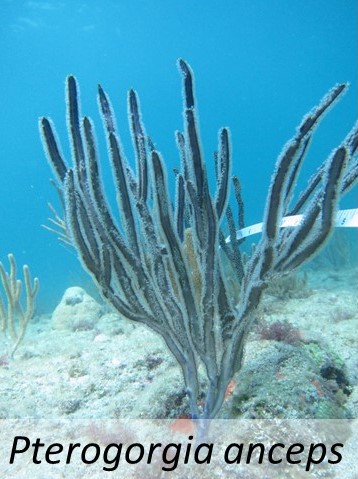
Family: Gorgoniidae
Common Name(s): Angular sea whip, Purple sea blade, Purple ribbon
Colony Form: Large, bushy and often highly branched; usually to 60 cm tall, sometimes to 1 m.
Axis: Black, slightly compressed.
Branches: Flat, with 3-4 flaps or flanges producing a “Y” or “X” cross section. Branch width 3-6 cm; tapered from the base and often twisted; tips long and thin, pointed or flattened.
Apertures: Polyps emerge from a common groove along branch edges.
Mucus: None
Color: Dark purple, purple or with purplish tints; occasionally olive brown, gray, yellow or a combination of yellow and purple. Purple, dark pink, yellow, or a combination when dried.
Sclerites: Polyp armature: small, blunt rods with few weak bumps or thorns, to 0.08 mm long, the largest often with slightly swollen ends. Body wall: stout spindles with large simple to complex tubercles, to 0.18 mm long; scaphoids (curved sclerites) often with blunt, finely tuberculate ends, to 0.14 mm long; ornamentation of scattered simple to complex tubercles and almost smooth convex surface.
Habitat: Back reefs with wide range of water qualities; hard substrates, often arising from buried hard substrates; 1-20 m depth.
Distribution: South Florida, Bahamas, Caribbean Sea.
Notes: The largest species in Pterogorgia. Although the 3-4 blades on any given branch generally distinguish P. anceps from P. guadalupensis, which has flat blades up to 10 mm across near the base and tends to branch in a single plane, recent molecular evidence suggests that a continuum exists between these two species. All Pterogorgia spp. shed the outer layer of their rind if it becomes overgrown by algae (Collin et al. 2005).
Similar Species: Pterogorgia citrina























